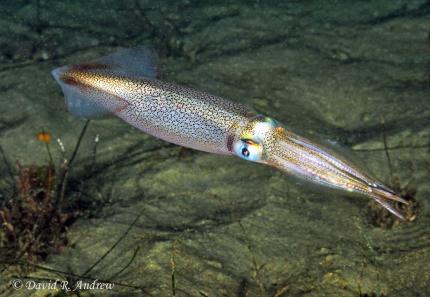
Washington regulations classify all squid (Sepiolida or Teuthida) as shellfish. This includes market squid (Loligo opalescens), also known as opal squid, common market squid or California market squid. Opal or market squid are generally distributed throughout the Washington coast, Puget Sound, the Strait of Juan de Fuca, and the San Juan Islands.
Regulations differ for squid harvested commercially in Puget Sound and coastal waters.
For information on coastal squid fisheries, contact Lisa Hillier at 253-250-9753 or Lisa.Hillier@dfw.wa.gov
For information on Puget Sound squid fisheries, contact Roy Clark at 360-302-3030, ext. 317 or roy.clark@dfw.wa.gov.
Regulations
What is required to fish for squid in Washington?
Licenses , permits, and logbooks:
- A squid fishery license, 0-3 nautical miles (nm).
- A non-limited delivery license when fishing only in federal waters (3-200 nm) and delivering into Washington.
- Crew member license.
- Plus, for purse seine gear only, a permit issued by the WDFW Director.
- Vessel operators must obtain and accurately maintain onboard a squid harvest log provided by WDFW.
What areas are open/closed to fishing for market squid?
- Pacific Ocean: Open 0-200 nm offshore the Washington coast.
- Puget Sound: Open, except closed within 1/4 mile of the shoreline of an incorporated city or town.
What is the season for commercial squid fishing?
Commercial squid fishing is open year-round.
What are the legal fishing gears for market squid?
Refer to WAC 220-340-770.
Statewide gears
- Dip bag net or brail: may not exceed 10 feet in diameter, 1 inch minimum stretch measure net mesh size.
- Squid jigging gear.
Willapa Bay, Grays Harbor, Lower Columbia River
Statewide gears, plus:
- Drag seine gear: 350 feet maximum net length, 1 1/4 inches minimum stretch measure net mesh size.
Coastal
Statewide gears, drag seine gear, plus:
- Purse seine, in WA state waters (0-3 miles) by permit only.
- Purse seine, in federal waters (3- 200 miles).
Lighting systems, applies to all areas
- Maximum combined power of 10 kilowatts.
- Lights of 200 watts or greater must be shielded and may not be directed to any point more than 100 feet from the vessel while fishing for or attracting squid.
Are there catch limits?
Yes, a 2000 metric ton harvest guideline applies to catch and landings from coastal waters in the purse seine gear fishery.
What about bycatch?
Only octopus caught incidentally to squid fishing may be retained. All other species must be returned to the water immediately.
Harvest guideline
A harvest guideline has been established for the coastal non-treaty squid fishery. No quota applies to squid fishing in Puget Sound.
Coastal Squid Harvest Guideline (metric tons) per calendar year | Landings to date | Remaining Harvest Guideline (metric tons) |
|---|---|---|
| 2000 | 0 | 2000 |
Emergency Rule Change - Puget Sound
Puget sound commercial squid fishery WSR 20-23-019 filed on November 6, 2020 (PDF)
WAC 220-340-77000C Commercial squid fishery
Notwithstanding the provisions of WAC 220-340-770, effective immediately, until further notice, the following applies to Puget Sound as defined in WAC 220-340-010 only:
It is unlawful to fish for squid for commercial purposes with drag seine gear.
WAC 220-340-03000G Shellfish harvest logs
Notwithstanding the provisions of WAC 220-340-030, effective immediately, until further notice, the following applies to Puget Sound as defined in WAC 220-340-010 only:
It is unlawful for vessel operators engaged in commercial harvest of squid, except when taken incidental to any other lawful fishery, to fail to permanently and legibly record in ink the following information before leaving the Marine Fish-Shellfish Management and Catch Reporting Area where taken: The vessel's Washington department of fish and wildlife boat registration number, gear type, catch area, location (nearest landmark, bay, or GPS coordinates), starting and ending time of fishing, total vessel wattage of attracting lights, average depth of harvest, and numbers of other species caught and returned
Permanent WACs
- WAC 220-340-770 Commercial Squid Fishery
- Emergency Commercial Fishing Regulations (eWACS)
- Shellfish Harvest Logs. WAC:220-340-030
- Fish Rules of General Application. WAC:220-305
- Shellfish - Definitions, Classifications and General Rules. WAC:220-320
- General Commercial Fishery Rules. WAC:220-353
- Sale of Commercially Caught Shellfish. WAC:220-340-040
- Fish Receiving Tickets, Sales, Commercial Duties, and Recordkeeping. WAC:220-352